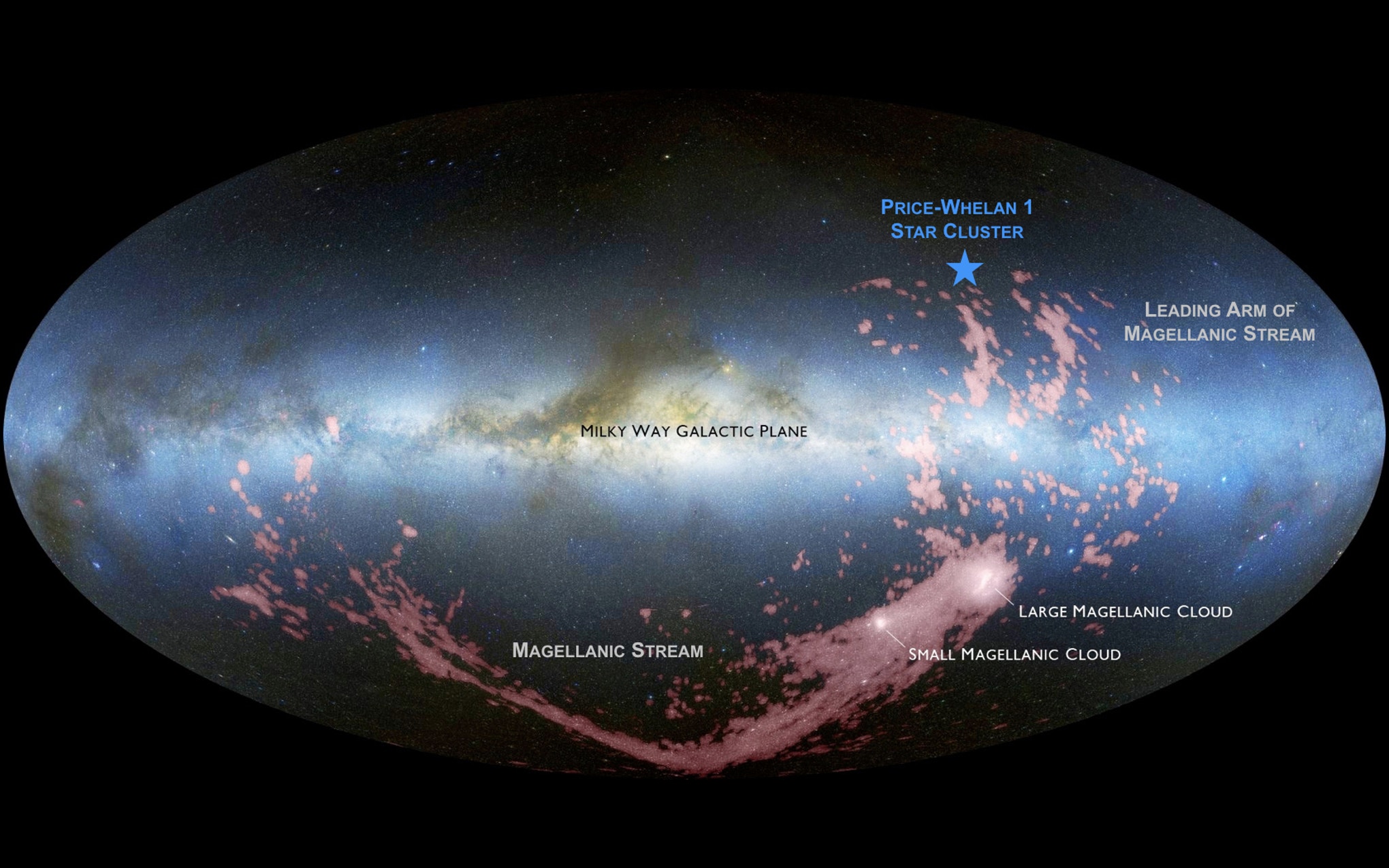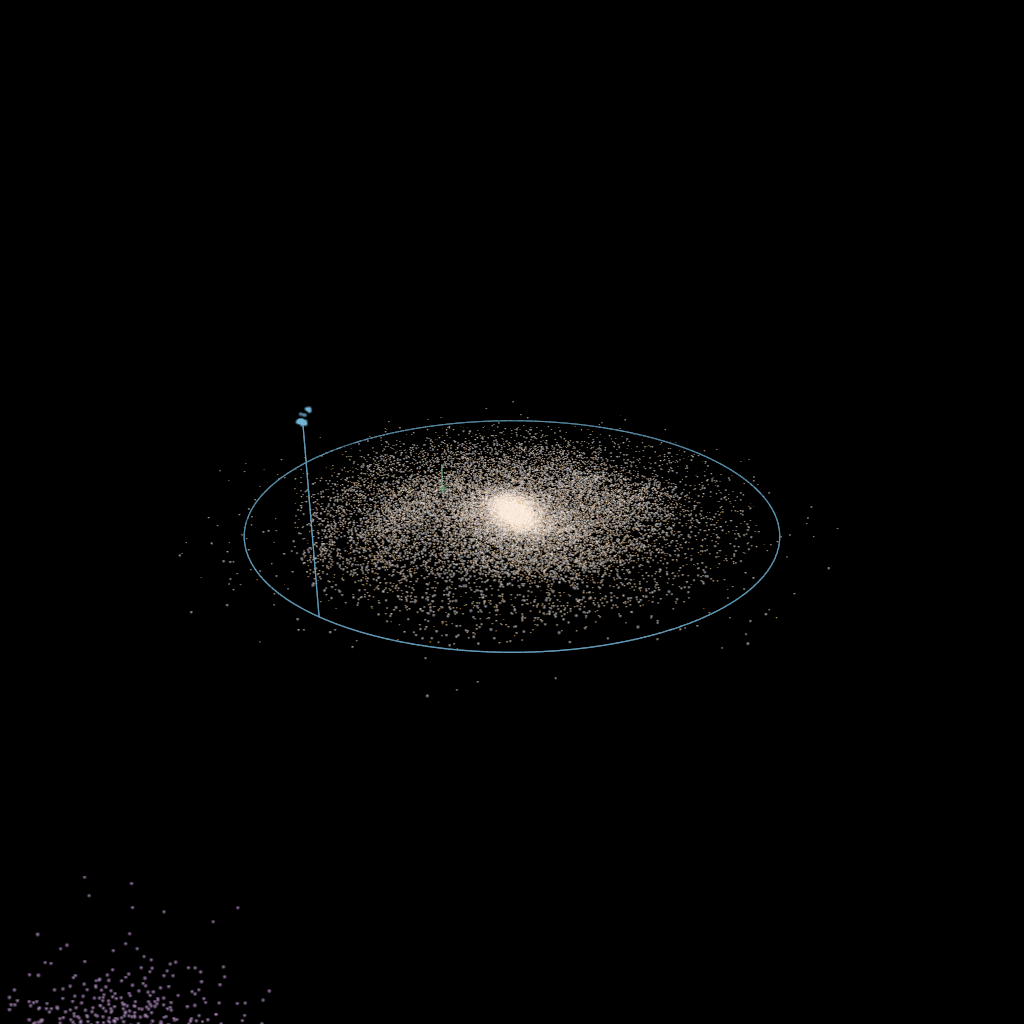IoW_20200109 - Gaia
Image of the Week |
Discovery of a new star cluster: Price-Whelan 1 |
|
|
|
Distant Neighbours: a newfound cluster of young stars (blue star) sits on the periphery of the Milky Way. These stars probably formed from material originating from neighbouring dwarf galaxies called the Magellanic Clouds. Credit: D. Nidever; NASA. |
|
Astronomers have spotted a new group of young stars in the outskirts of the Milky Way. It is relatively young at 117 million years old but further than any known young stars in the Milky Way. Adrian Price-Whelan, primary discoverer of this new star cluster, started with a meticulous search through the Gaia data for very blue stars, stars which are rare in the universe. Then identifying the clumps of stars moving alongside them. The remaining data were cross-matched with known clusters to remove those, after which this clump of stars remained thus leading to the discovery of a new star cluster "Price-Whelan 1". Spectral analysis suggests that the young stars have an extragalactic origin, more specifically coming from the two nearby dwarf galaxies known as the Magellanic Clouds. These galaxies will collide with the Milky Way at some point in the future and astronomers wonder if they collided with our galaxy already in the past. These newfound stars can help us to better understand the history of the Milky Way.
“This is a puny cluster of stars — less than a few thousand in total — but it has big implications beyond its local area of the Milky Way,” says primary discoverer Adrian Price-Whelan, a research fellow at the Flatiron Institute’s Center for Computational Astrophysics in New York City.
FAR OUT: Astronomers have spotted a group of young stars (marked in blue) on the outskirts of the Milky Way. The scientists propose that these stars formed from material from two dwarf galaxies known as the Magellanic Clouds. Credit: A.M. Price-Whelan.
The cluster inhabits a region near a river of gas, called the Magellanic Stream, that forms the outmost edge of the Large and Small Magellanic Clouds and reaches toward the Milky Way. The discovery of "Price-Whelan 1" already suggests that the stream of gas extending from the Magellanic clouds to our Milky Way is about half as far from the Milky Way as previously thought. Using the current positions and movements of the stars in the cluster, the edge of the Magellanic clouds is predicted to be 90,000 light-years away from the Milky Way.
“If the Magellanic Stream is closer, especially the leading arm closest to our galaxy, then it’s likely to be incorporated into the Milky Way sooner than the current model predicts,” Nidever says. “Eventually, that gas will turn into new stars in the Milky Way’s disk. Right now, our galaxy is using up gas faster than its being replenished. This extra gas coming in will help us replenish that reservoir and make sure that our galaxy continues to thrive and form new stars.”
The updated distance to the Magellanic Stream is expected to improve the modelling of the Magellanic Clouds and shed light on where they have been and where they're going. LOCAL GUIDE: A visualisation of the position of the newfound Price-Whelan 1 star cluster (blue points) relative to the Milky Way (white points). The star cluster probably formed from material from the Large and Small Magellanic Clouds (purple points). The vertical green line shows the location of the Sun. Credit: A. Price-Whelan; Simulation by J. Hunt.
References:
|
|
Credits: A.M Price-Whelan (Center for Computational Astrophysics, Flatiron Institute, New York), D. Nidever (NASA), Simons Foundation [Published: 09/01/2020] |
- Removed a total of (12) style text-align:center;
- Removed a total of (5) style text-align:justify;
- Removed a total of (1) border attribute.
- Removed a total of (1) cellpadding attribute.
- Removed a total of (1) cellspacing attribute.
Image of the Week Archive
- Removed a total of (1) border attribute.
- Removed a total of (1) cellpadding attribute.
- Removed a total of (1) cellspacing attribute.








































 Sign in
Sign in
 Science & Technology
Science & Technology


